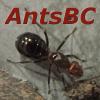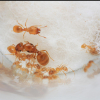Hey everybody,
After keeping this colony for around 2-3 months, I have finally decided to start a Journal on them!
I caught this queen while I was at a camp up in the boonies about 2-3 months ago, in June if I recall correctly.
The queen when I first caught her
So now I'll get into getting her colony started. After a few attempts of giving her pupae of different Formica in the fusca group, I realized that she was unable to open cocoons.
My queen with dying pupae
Knowing that the queen couldn't open pupae, I released her into a queen-less Formica pacifica colony that was living in a naturalistic setup at the time. Some of the workers apparently wanted the queen to become their queen and some disagreed, so eventually, I took the queen out of the setup in fears that the workers were going to kill her as the aggression level was rising. What I decided to do instead was get two callow workers and around 10 pupae from the same colony and offer it to the queen in a outworld that I connected to the test tube I had her in. She almost immediately ran into the outworld and ran up to the workers. It seemed one worker didn't trust the queen and was scared while the other was interested in the queen in a good way. Eventually what happened was, the one worker joined/united with the queen while the other worker still stayed away from the two. Later the worker joined the newly founded "colony" and they started to open pupae.
For a while, the newly founded colony didn't want to enter the test tube. Eventually, I got them to move by using airflow to disturb them. This picture shows them in the outworld before they moved into the test tube.
The colony after I got them to move into the test tube. They had a lot of pupae back then, but only 2 or 3 of those actually became workers. I'm still not sure where all the pupae went to this day. Most likely, the colony ate them.
Currently, they have about 10 workers and no eggs. I don't expect the queen to lay until after hibernation. I'm really hoping she's fertile as I would love to start a colony of these guys. I just moved them into a new test tube today. here's a short video of them in the new one after the move:
Thanks for reading this gigantic post lol.
Edited by AntsBC, July 29 2020 - 1:46 PM.
























